



and his illustrators
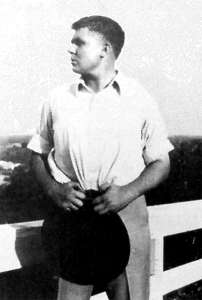
I put a premium on illustrators in my collection. My shelves are arranged alphabetically by illustrator. Drove my mom crazy. She was a librarian and when she saw Robert Louis Stevenson in the "G" section (for Godwin) and the "R" shelves (for Rhead) and in with the "W"s (for Wyeth), it's all she could to do restrain herself from doing a major Dewey Decimal System reorganization behind my back. She always resisted, but I knew she wanted to.
Robert E. Howard was a writer, but he does have a section in various places on my shelves. He's there - right between Brad Holland and Adam Hughes. And he's one of the worst offenders in my mom's eye since I have illustrated books by him everywhere! Why?
Robert Ervin Howard was born in 1906 and died in 1936 from a self-inflicted gun wound. He shot himself upon learning that his terminally ill mother was never going to regain consciousness. She died 14 hours later. He sold his first story at age 18 and was writing up to his death. A dozen years, that's all. He never wrote a book. He did write two novels, one published in serial form and the other over 50 years after his death. How many other authors get their novels published 53 years posthumously? What makes Howard so special?
That's a very good question and one that readers and critics have been pondering for years. Howard wrote for the pulp magazines and he wrote adventure stories featuring macho heroes - boxers, cowboys, barbarians, etc. Guy stuff. But, then so did lots of others at the time and nobody's publishing their novels today. Nobody has 25 pastiches of his work in print with more being created monthly. What did he do? Well, he created Conan the Barbarian for one thing. Some of you may have heard of him.

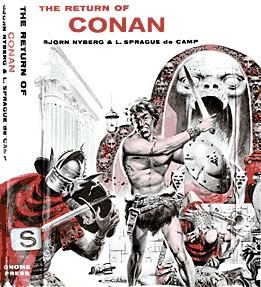 A
lot of people of my generation were introduced to him via the
book pictured at left. Yes, that's Frank Frazetta [1966] on the cover of Conan
the Adventurer and the book re-catapulted both men to instant
popularity with a new generation. Others, including myself at
the ripe old age of eight or nine got our first exposure in the
1950's when Gnome Press released collections of his work in hardback.
Yes, like the one with the Wally
Wood version of The Return of Conan at right [1957].
It may be genuine Wood, but it's ersatz-Howard. When Gnome Press
ran out of Conan material by Howard, they simply
created some more. Hey, the guy was dead. He wouldn't mind. Some
people noticed the difference, others didn't. I did. So did Karen,
who along with other women I know, likes the original material,
thus calling into question my "guy thing" theory. Drat!
A
lot of people of my generation were introduced to him via the
book pictured at left. Yes, that's Frank Frazetta [1966] on the cover of Conan
the Adventurer and the book re-catapulted both men to instant
popularity with a new generation. Others, including myself at
the ripe old age of eight or nine got our first exposure in the
1950's when Gnome Press released collections of his work in hardback.
Yes, like the one with the Wally
Wood version of The Return of Conan at right [1957].
It may be genuine Wood, but it's ersatz-Howard. When Gnome Press
ran out of Conan material by Howard, they simply
created some more. Hey, the guy was dead. He wouldn't mind. Some
people noticed the difference, others didn't. I did. So did Karen,
who along with other women I know, likes the original material,
thus calling into question my "guy thing" theory. Drat!
Howard wrote poetry, some of it among the most powerful I've read. He created memorable characters for different genres of the pulps: King Kull and Solomon Kane, Breckenridge Elkins, Steve Donovan and Dennis Dorgan, and dozens more. His medium was the short story and the occasional novelette - the bread and butter of the writers who were paid by the word.
I'm going to leave the wannabees behind (several new "Conan" novels come out every year - it's big business). The psychoanalysis should be dealt with by those much more qualified than I (there are several biographies of Howard available from Donald M. Grant and there was even a film - The Whole Wide World - devoted to his life). I don't think the 'revivals' are worth the bits it would take to name them and Howard's biographers do a much better job on the very complex subject that was Robert E. Howard than I could ever hope to accomplish in this short space. So I'll let Howard speak for himself and I'll talk about illustrators!
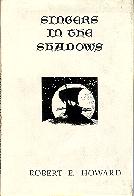
|
Singer in the Shadows 1970 Donald M. Grant Illustrated by Robert Bruce Acheson |
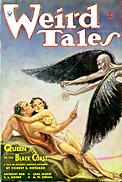 When
Howard's stories were first published, they were often illustrated
and occasionally the young writer would merit a coveted cover
appearance, i.e. one of his stories would be selected as the subject
to be featured as a color cover painting. Margaret Brundage, the
artist for the cover at left which spotlighted REH's Queen
of the Black Coast for the May 1934 issue of Weird
Tales stated "Howard was my favorite author. I always
liked his stories the best. (Seabury) Quinn was alright, but I
liked Howard's much better." There's another hole in my "macho/guy
thing" theory.
When
Howard's stories were first published, they were often illustrated
and occasionally the young writer would merit a coveted cover
appearance, i.e. one of his stories would be selected as the subject
to be featured as a color cover painting. Margaret Brundage, the
artist for the cover at left which spotlighted REH's Queen
of the Black Coast for the May 1934 issue of Weird
Tales stated "Howard was my favorite author. I always
liked his stories the best. (Seabury) Quinn was alright, but I
liked Howard's much better." There's another hole in my "macho/guy
thing" theory.
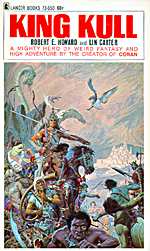 When
Gnome Press compiled his work into hardcover in 1950-57, the cover
artists included a young Frank
Kelly Freas, Ed Emshwiller and the above-mentioned Wally Wood.
And the next REH incarnation/revival, the Lancer paperbacks that
started in 1966, featured some of the most powerful work ever by
Frank Frazetta and Roy
Krenkel - including a collaboration on the powerful King
Kull, though, again, the textual content of this volume was
a mixture of pure REH and Lin Carter homage. Those Conan
and Kull and Bran Mac Morn books started a still-thriving
Howard revival and almost single-handedly launched a new fiction
genre, Sword and Sorcery.
When
Gnome Press compiled his work into hardcover in 1950-57, the cover
artists included a young Frank
Kelly Freas, Ed Emshwiller and the above-mentioned Wally Wood.
And the next REH incarnation/revival, the Lancer paperbacks that
started in 1966, featured some of the most powerful work ever by
Frank Frazetta and Roy
Krenkel - including a collaboration on the powerful King
Kull, though, again, the textual content of this volume was
a mixture of pure REH and Lin Carter homage. Those Conan
and Kull and Bran Mac Morn books started a still-thriving
Howard revival and almost single-handedly launched a new fiction
genre, Sword and Sorcery.
I said that I have a lot of Howard books in a lot of different places on my shelvess. The reason is that almost everything he's ever written has been released, starting in the early '70s, in illustrated hardback editions. I have often wondered why his work seems so naturally associated with images and why generally the best artists in the business are drawn to his material and inspired by it. I think there's a power in Howard's writing that certainly conjured up images in my ten-year old brain that were unlike any put there by Edgar Rice Burroughs, the only possible comparable author in terms of popularity and longevity. That power obviously resonates with the artistic brain as well. Here's just a handful of images inspired by his words...
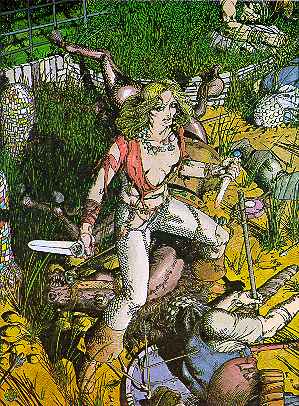
|
Valeria of the Red Brotherhood 1975 REH Portfolio from Gorblimey Press "Her sword was a living thing in her hand. Where Conan beat down opposition by the sheer weight and power of his blows, ... Valeria brought into action a finesse of swordplay that dazzled and bewildered her antagonists before it slew them. Again and again a warrior, heaving high his heavy blade, found her point in his jugular before he could strike." Conan - Red Nails - 1936 Illustration by Barry Windsor Smith |
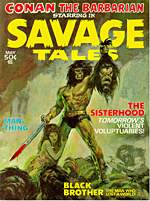 Barry
(later Windsor-) Smith was the first artist on the Conan
comic book when it debuted in 1970. It lasted for over 270 issues,
though his work only appeared up until issue #24. John Buscema
was his replacement and Smith's lyrical, almost Pre-Raphaelite
stylings gave way to Conan as man/brute - the Frazetta model as
seen in the Lancer paperback cover above and in John Buscema's
cover for the 1971 magazine, Savage Tales, which was soon
replaced by The Savage Sword of Conan. Buscema drew Conan
in the comic books, the comic magazines and the newspaper comic
strip for longer than any other artist.
Barry
(later Windsor-) Smith was the first artist on the Conan
comic book when it debuted in 1970. It lasted for over 270 issues,
though his work only appeared up until issue #24. John Buscema
was his replacement and Smith's lyrical, almost Pre-Raphaelite
stylings gave way to Conan as man/brute - the Frazetta model as
seen in the Lancer paperback cover above and in John Buscema's
cover for the 1971 magazine, Savage Tales, which was soon
replaced by The Savage Sword of Conan. Buscema drew Conan
in the comic books, the comic magazines and the newspaper comic
strip for longer than any other artist.
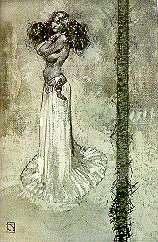
|
Nakari, Queen of Negari "The Woman was clad as she had been when he had seen
her on the throne, and the colored armlets and anklets clanked
as she closed the door behind her and came into the room. She
moved with the easy sinuousness of a she-leopard and in spite
of himself the watcher was struck with admiration for her lithe
beauty." |
|
Interestingly enough, Jones illustrated this same collection of stories a decade earlier, also for Grant. It's not often that one can examine the development of an artist by his approach to the same material over time. In the mid-1970's, Zebra paperbacks published a dozen collections of REH non-Conan fiction, all with stunning new covers, and a couple with interior illustrations, by Jones. |
|

|
Muhammad Khan "I saw Muhammand Khan sitting his great white stallion
in the midst of his emirs as cooly as if he watched a parade
- yet the flickering blades of our screaming devils were a scant
spear-cast from him. His lords thronged around him..." |
| This was a follow-up to his 1973 masterpiece, The Sowers of The Thunder, also from Donald M. Grant, that had over 100 marvelous pen & ink drawings. Krenkel is also known for his seminal covers for the Edgar Rice Burroughs reissues from Ace in the early 1960's. | |
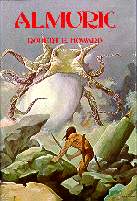
|

|
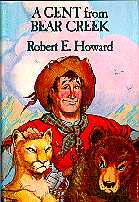
|
|
Illus. David Ireland 1975 Donald M. Grant 1939 |
Illus. Tim Kirk 1974 Donald M. Grant |
Illus. Tim Kirk 1975 Donald M. Grant 1934-36 |

|
Michael W. Kaluta illustrated two volumes of Howard's tales of the East featuring his heroes Francis Xavier Gordon and Kirby O'Donnell. The Lost Valley Of Iskander and The Swords of Shahrazar were published by FAX in 1974 and 1976 respectively and magnificently illustrated in color and line. |

|
Steve Fabian did the dust jacket and the b&w interior
illustrations for this 1973 Fictioneer collection of two REH
western tales from 1936.
Steve also created wonderful plates for three portfolios inspired by Howard: The Queen of the Black Coast, The Tower of the Elephant and Almuric - each in a style reminiscent of Finlay. |
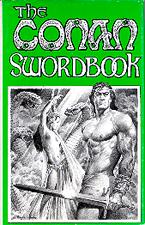
|
There were Howard magazines in the 1950's and 1960's. The most famous was Amra and as the Sword and Sorcery genre grew, so did the discussions and dissections. Mirage Press collected the discourse and drawings into hardback volumes like 1969's The Conan Swordbook and 1972's The Conan Grimoire. George Barr's cover at left is another vote for a less-hulking, yet still very well-endowed, hero. |
The mention of George Barr allows me to segue into a suggestion for the Conan fan. There is literally ten times more material featuring Conan available today than Howard ever wrote. Fortunately, publisher Donald M. Grant has collected the original canon into eleven matching volumes containing only the original REH tales. Each is illustrated (natch!) with color & b&w plates and the artists include: Richard Robertson, Ned Dameron, Hank Jankus, Marcus Boas, Michael Hague, Dan Green, David Ireland, Alicia Austin, Ezra Tucker, Dean Morissey and George Barr (on Red Nails). If you want to separate the wheat from the chaff and experience only the best, this set is the one to seek out. Some of which may still be available at cover price from Donald M. Grant.
 Another great new source for the real thing is Wandering Star, a new publisher
releasing heavily illustrated editions of Howard's stories. Their
first release was the 1998 volume, The Savage Tales of Solomon
Kane with color plates and scads of pen drawings by Gary Gianni
(at left).
Another great new source for the real thing is Wandering Star, a new publisher
releasing heavily illustrated editions of Howard's stories. Their
first release was the 1998 volume, The Savage Tales of Solomon
Kane with color plates and scads of pen drawings by Gary Gianni
(at left).
The Ultimate Triumph is their second production and it features Howard's prose, poetry and even, at this late date, unpublished material. The illustrations are by Frank Frazetta and there must be nearly a hundred of them.
Of course, there are many others who have been graphically inspired by Howard's writings and they are too numerous to mention here. Rick Berry, Phil Hale, Steve Leialoha and Richard Corben come immediately to mind. And if we delve into the world of the comic books, we have to list Ernie Chan, Alfredo Alcala, Alex Nino, Neal Adams, Gil Kane, Esteban Maroto, Frank Thorne and Boris Vallejo as just the tip of the iceberg.
It's an amazing legacy for a young man who for twelve years wrote pulp fiction. From the lowest rung on the literary ladder to deluxe limited editions sixty years later, newly illustrated by the masters of the medium is a pretty big stretch. His contemporaries (and oft-times correspondents) like H.P. Lovecraft and August Derleth are still recognizable names, yet they are seldom the subject of illustrated versions of their work - and when they are, the adaptation and illumination seldom works to the advantage of either the text or the art. Other contemporaries such as E. Hoffman Price and Clark Ashton Smith were drawn back to the shelves of bookstores in the wake of the Howard vortex and did not spark any graphic notice or interest whatsoever.
Only Howard's writings have resonated to this degree. It's really not hype. It simply can't be. Granted that there are innumerable instances of hypesters taking advantage of his talent and "continuing" the adventures of his characters. But the original needs no apologies. He was truly an original and an excellent writer. He had to be in order to leave the legacy that he did. Even my mom might like his work, if only she knew where to look for it on my shelves.

To learn more about Robert E. Howard, see:
| The Last Celt | Glenn Lord, 1976 Donald M. Grant |
| The Weird Tales Story | Robert Weinberg, 1977 Fax |
| Weird Tales | Alistair Durie, 1979 Jupiter |
| Dark Valley Destiny: The Life of Robert E. Howard | L. Sprague de Camp, Catherine Crook de Camp, Jane Whittington Griffin, 1983 Bluejay |
| One Who Walked Alone: Robert E. Howard - The Final Years | Novalyne P. Ellis. 1986, Donald M. Grant |
| Post Oaks and Sand Roughs | Robert E. Howard, 1990, Donald M. Grant |
| The Vadeboncoeur Collection of Knowledge | Jim Vadeboncoeur, Jr. 2000 |
|
Illustrations are copyright by their respective owners. This page written, designed & © 2000 by Jim Vadeboncoeur, Jr. Updated 2011. |
